Coggeshall is a small historic market town and is regarded as one of the prettiest in Essex. It is uncertain from where the word Coggeshall derives, but it is mentioned in the Doomsday Book of 1086, as well as on a grant of the same period.
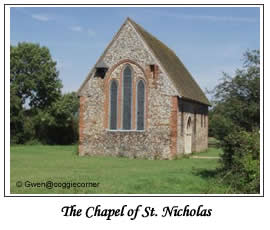
The town was the site of a Roman encampment, but it was the founding of the Cistercian Abbey by King Stephen and Queen Matilda in 1140, which was the most significant event in Coggeshall’s history. The monks farmed sheep and it was this that led to the foundation of the town’s prosperous wool trade during the 15th to 18th centuries.
Some of the abbey buildings still remain, including the chapel of St. Nicholas which was built of local brick in around 1220. After the dissolution of the monasteries, it fell into disrepair and was used as a cow shed and barn. In the late 1800s it was restored and has been a place of worship ever since.
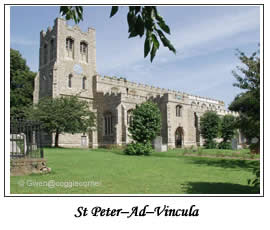
Grange Barn, built in 1140, was also originally part of the Cistercian Abbey. It is situated on Abbey Lane, which is part of the route of ‘The Essex Way’ long distance footpath. It is the oldest surviving timber framed barn in Europe and measures 120 feet long by 45 feet wide and 35 feet high at the apex of the roof, which was originally thatched but replaced with tiles around the 14th century. Today the barn is owned by the National Trust and open to the public.
It was the wool merchants’ wealth which financed the building of the cathedral style church of St Peter–Ad–Vincula in the 15th century. It is one of the largest churches in Essex.
The Roman Catholic church of St Bernard of Clairvaux, and the Baptist/Methodist Christ Church (formerly the Congregational Church) are the other two churches in Coggeshall.
Opposite Christ Church is the local library which was once the Friends Meeting House, and it was here that the founder of the Quakers, George Fox, visited in 1655 and gave a speech to 2000 people.
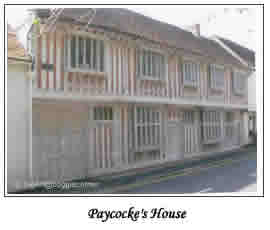
Coggeshall is home to over 200 listed buildings, some of which are owned by the National Trust and date from the time of the wool trade, such as Paycocke’s House.
Paycocke’s House is a 16th century timber framed building in West Street, which was built by the prosperous wool merchant, John Paycocke, as a wedding present for his youngest son. It is one of the most interesting buildings in Coggeshall, with a wonderfully panelled interior, with richly carved ceiling beams. The garden is planted in keeping with the age of the house.
The Woolpack Inn was built in the 15th century and, although the original owner is unknown, it is said that it once belonged to one of Coggeshall’s rich wool merchants. Between 1665 and 1708, the house was used as a non-conformist chapel, and in 1708 became an inn known as ‘The Woolpack’.
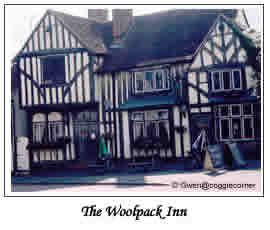
The town became particularly renowned for its fine Coggeshall white cloth until the collapse of the wool trade at the end of the 18th century, when new industries were founded producing the luxury textiles of silk, velvet and lace.
The form of lace made here was called ‘Tambour Lace’, which had been introduced in around 1812 by French emigrant, Monsieur Drago, who had settled in Coggeshall with his two daughters. The town’s lace was sold to retailers in London, such as the department store, Libertys.
The town produced the blue and crimson silk velvet for the coronations of both Edward Vlll and George V.
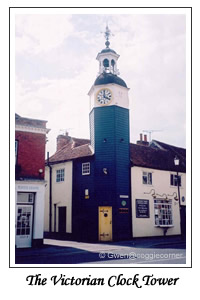
Coggeshall was home to many local businesses such as carriage makers, saddle and harness makers, butchers, bakers etc, well into the 20th century. There used to be four breweries here, with the beer noted for its remarkable quality, which was said to be due to the excellent local water supply. One brewery, Messrs E. Gardner & Son was awarded a diploma of honour for the sale of their beer at the National Brewers Exhibition in 1888. The local weekly market has been running since 1256, after receiving a Royal Charter from Henry III.
The town was the home to Mr John Kemp King who founded Kings Seeds; he had a shop and warehouse, and acquired land which he used for his seed trials of mainly sweet peas. The company still trades today and is widely known, although its premises are no longer in the town, but on the Kelvedon Road.
If visitors enter the town along this road they can at first smell a heavy perfume and as they start to wonder where it comes from, they turn a corner to see acres of land full of colourful sweet peas.
Today the town has moved with the times, with many of its workers commuting into London from the station at nearby Kelvedon, which is connected to Coggeshall by a volunteer run community bus service. This also transports the older generation of local residents to their daily activities, including the weekly market.
Coggeshall is a thriving community and is now often referred to as a village. There are many shops and businesses, as well as numerous local eateries, some of which are housed in the town’s many historic buildings. An old fashioned tea shop is located underneath the town’s clock, which was rebuilt for Queen Victoria’s Golden Jubilee in 1887.
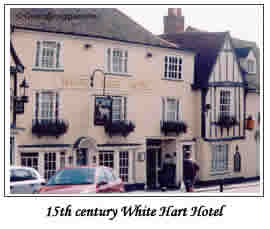
The younger generation is also well served with primary and secondary schools, as well as nurseries. The secondary school has its own swimming pool and gym which is open to the community at a very reasonable price.
There are plenty of recreational and leisure activities for all age groups, including playgrounds and sporting facilities.
Also there are many local societies and these include the Coggeshall Heritage Society, the Coggeshall Art Group, the Horticultural Society, the Women’s Institute, the Royal British Legion and the Scout and Guide movements.
The town has an excellent community spirit, with volunteers organising monthly footpath walks and maintaining the public gardens.
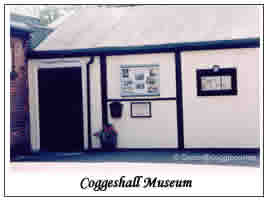
Our local museum was opened in 1990 in an annexe to St Peter’s Hall (now the Village Hall) in Stoneham Street and is run by volunteers. They are, and I quote them, “Preserving Coggeshall’s historic past and recording today for the future”. The hall itself was formerly one of Coggeshall’s breweries. Items on display are changeable, as they are loaned or donated by members of the community. Entrance is free, although donations are welcome to cover costs.
I have lived in Coggeshall for 18 years and love it here. I try to walk around the village every day and enjoy the legacy of history that has been left. I am glad that I have written this article as I have learnt so much more about Coggeshall and have to say that I found it very difficult choosing what to include.
I have left out numerous things and can only suggest that you visit Coggeshall yourself. I feel Essex is a much underrated county and is often the butt of many jokes, so hope this article will dispel any future derogatory thoughts.
Gwen@coggiecorner
© Gwen@coggiecorner 2008
SOURCES
A History of Coggeshall by George Fred Beaumont ISBN 978-0953916504